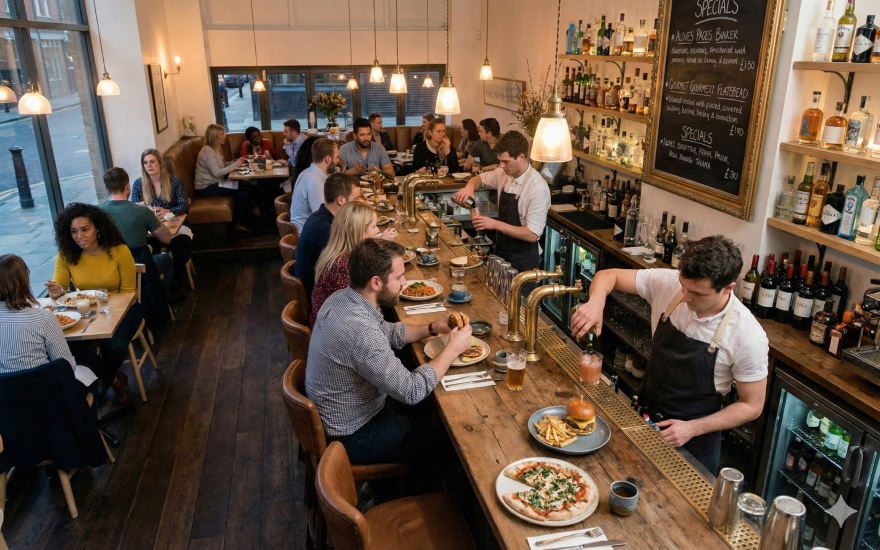5 Common Restaurant Payroll Errors and How to Avoid Them

A common phrase heard amongst restaurant employees is, “I can’t wait until payday.” However, for business owners who aren’t familiar with running their own restaurant payroll, payday can feel daunting. Managing employee hours and tips can be difficult and can lead to costly mistakes if you don’t stay compliant with changing labor and tax laws. According to EY, each payroll error costs companies an average of $291 to fix directly and indirectly. While automated payroll systems can help streamline your restaurant payroll operations, familiarizing yourself with the basics will leave you well-equipped to prevent potential errors.
In this article, we’ll be diving into the 5 most common restaurant payroll errors, with actionable tips on how you can avoid them.
How Common Are Restaurant Payroll Mistakes?
While there’s not much data available on the commonality of restaurant payroll mistakes, several factors suggest that the restaurant industry might be more susceptible to them, such as:
- Added Complexities: Navigating fluctuating hours, tipped wages, overtime hours, and more increases the chances of errors.
- Fast-Paced Environment: The high-pressure, fast-paced nature of the restaurant industry can lead to inaccuracies from time constraints and potential oversights.
- Limited Resources: Smaller restaurants may have limited resources to invest in payroll software or professional guidance.
In addition to these added risk factors, twice as many payroll mistakes happen with in-house payroll solutions (11.4% error rate) compared to outsourced payroll solutions (6.1% error rate). Therefore, while there’s no concrete answer for how common restaurant payroll mistakes are, they are more common for restaurants that run their payroll in-house.
Who is Responsible for Payroll Errors?
Ultimately, the responsibility for restaurant payroll errors falls on the employer, which would typically be the restaurant owner, manager, or accountant. Employees rely on their employers to oversee the payroll process properly and comply with labor laws. Although restaurant payroll errors can happen from a variety of factors, including human error or outdated systems, it’s still the employer’s responsibility to promptly fix these errors and take preventive steps to avoid them in the future.
What Payroll Laws Do Employers Have to Follow?
In the United States, employers have to follow both federal and state labor laws. The most well-known federal labor guidelines are established through the Fair Labor Standards Act (FLSA). The FLSA sets the national minimum wage, overtime pay requirements, and recordkeeping standards. In addition to the FLSA, federal laws also cover Social Security and Medicare taxes, federal unemployment, and equal pay to prevent discrimination. When it comes to state laws, they cover state minimum wage, regulations regarding wage and hour calculations, and state payroll taxes.
In Canada, the federal government sets federal labor standards that cover hours of work, leaves, termination, payroll deductions (including CPP and EI), equity, and occupational health and safety. While the federal government has overarching guidelines, each province and territory sets their own rules when it comes to minimum wage, overtime pay, meal and rest breaks, and vacation pay calculations.
If you’re unfamiliar with any of these labor laws, whether at the federal-level or local-level, be sure to do your research to maintain compliance and avoid any penalties. When researching, check official government websites for the most up-to-date and reliable information.

The 5 Most Common Restaurant Payroll Mistakes to Avoid
1. Mistakenly Classifying Employees
Before your employees even get their first paycheck, you’ll want to make sure that they’re being classified correctly as either an employee or independent contractor. This error can create many additional problems down the line, including underpayment of wages and overtime and failure to withhold taxes. For employees, employers must deduct payroll taxes in compliance with applicable tax authority guidelines. Meanwhile, independent contractors are responsible for their own taxes and benefits, which means that misclassification can leave the employer responsible for these costs.
Restaurant owners and managers need to familiarize themselves with the differences between employees and independent contractors by regularly checking IRS or CRA guidelines. Since restaurants often hire seasonal workers, this error may be more common than you think.
2. Inaccurate Time Tracking
Inaccurate time tracking can be a major problem in restaurant payroll, potentially leading to both financial and employee-related issues. Whether it’s from manual errors or forgotten clock-ins, inconsistent timekeeping results in incorrect wage calculations. Ultimately, this can lead to the underpayment or overpayment of employees, which can create frustration and potentially even legal trouble. On the financial side, these wage inaccuracies can negatively impact profitability by making it difficult to track labor costs and create schedules efficiently.
To prevent time keeping errors, implement a reliable time tracking system that alerts managers when someone clocks in outside of their scheduled hours, or forgets to clock in when they should. Some systems, like Push, also include facial recognition intelligence to prevent buddy punching and geo-location tracking to ensure all clock-ins happen on site. Additionally, managers should be auditing timekeeping data regularly to identify and resolve any discrepancies quickly.

3. Mishandling Tips and Gratuities
While it may not sound that serious, mishandling tips and gratuities can have severe consequences. Failing to follow regulations regarding tip pooling, reporting, and distribution can lead to potential legal and ethical concerns. Underpaying employees by withholding or misdirecting their tips can lead to hefty lawsuits and fines. On top of that, splitting tips inconsistently or unfairly can create tension among your team and negatively impact morale.
In an industry that relies so heavily on tips and gratuities, managers should implement a transparent tip-pooling system that follows legal guidelines. This policy should be communicated clearly to all employees to ensure everyone is aware of how tips will be handled. Using an automated payroll system specifically designed for restaurants can also help accurately track and distribute tips.
4. Failure to Comply With Updated Labor Laws
The restaurant industry is constantly evolving, and so are the labor laws surrounding it. Failing to comply with updated labor laws can result in serious consequences such as fines and lawsuits. These laws cover aspects like minimum wage, overtime pay, and meal breaks — and they can change at a moment’s notice. Not staying up to date on these laws can lead to an easily preventable, yet costly payroll mistake for restaurants.
Regularly checking reputable government websites and consulting with legal or HR professionals ensures you’re staying in the loop if any labor laws change. Additionally, fostering a culture of compliance among your team can potentially help you identify any potential issues early on.
5. Gaps in Reporting All Taxable Wages
Omitting any portion of an employee’s taxable wages from payroll records is a critical error with both financial and legal repercussions. Taxable wages for restaurant staff typically include tips, gratuities, and bonuses. Leaving any amount out of wage calculations can lead to inaccurate tax calculations and underpayment of payroll taxes. Not only can this result in fines and penalties, but your restaurant might be subject to audits from tax authorities as well. Under tax authorities like the IRS, underreporting taxable wages is considered to be a tax crime and should not be taken lightly.
To ensure all taxable wages are reported, implementing automated payroll software that gathers each employee’s total income to calculate taxes is essential. Automated payroll software also makes reporting easy, which allows you to regularly review payroll reports for any discrepancies. This software provides a hands-off approach, saving you time while still ensuring compliance.

Avoid Restaurant Payroll Errors With Automated Payroll Software
As a restaurant owner or manager, payroll might seem like just another task to complete. However, it’s a task that can come with serious legal consequences and penalties if done wrong. Most business owners aren’t payroll experts, so implementing automated payroll software can be a game-changer. Automating mundane tasks like timekeeping and tax calculations streamlines your processes, all while minimizing errors and ensuring compliance. Free up valuable time and resources, so you can focus on what matters most – running a successful restaurant.
While navigating restaurant payroll can feel overwhelming, the good news is that you don’t have to do it alone. See how Push can help with our cloud-based automated payroll software that’s specifically designed for restaurants. Book a demo to learn more today.



